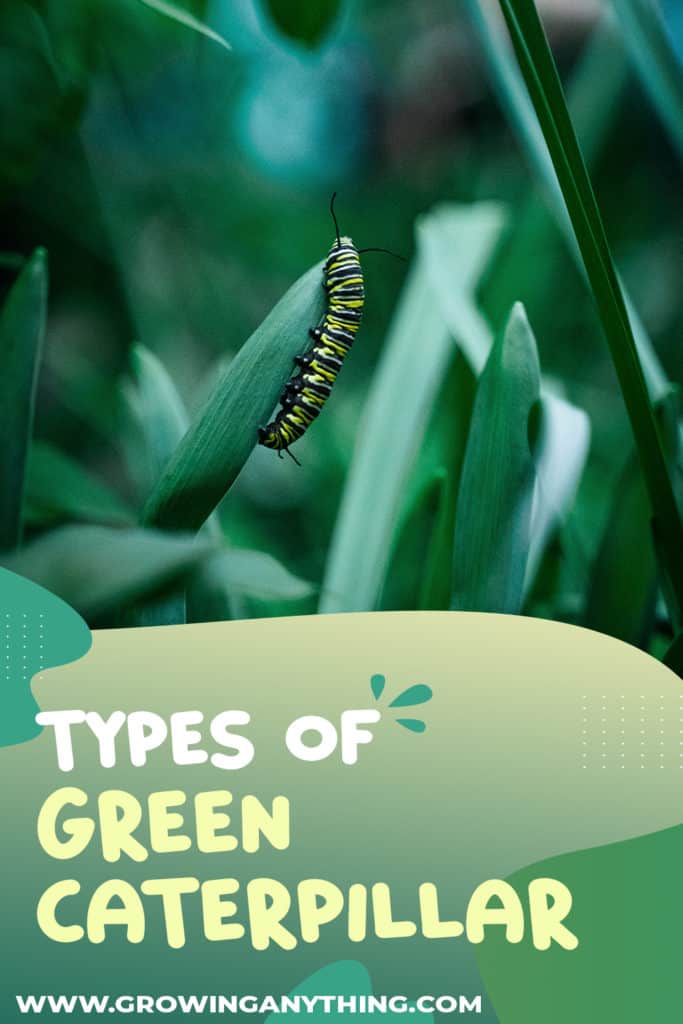32 Types of Green Caterpillar
Here is a guide that will help you identify different types of green caterpillars! They can chew leaves and cause severe harm to the lovely plants in your garden. After the caterpillars have fed on your plants and veggies, they often leave the crops inedible.
But, if you react on time you can get rid of them safely.
Some hardy trees can survive green caterpillars feeding on their foliage. But, the tree survives as long as it isn’t under another type of stress, such as drought.
When dealing with green caterpillars you can try microbial insecticide, but the treatment might not be effective against all insects. Or, it can harm pollinators and bees. Therefore, it is important to know what kind of caterpillars are in your garden. So you can pick the treatment accordingly.
Here is a simple green caterpillar guide!
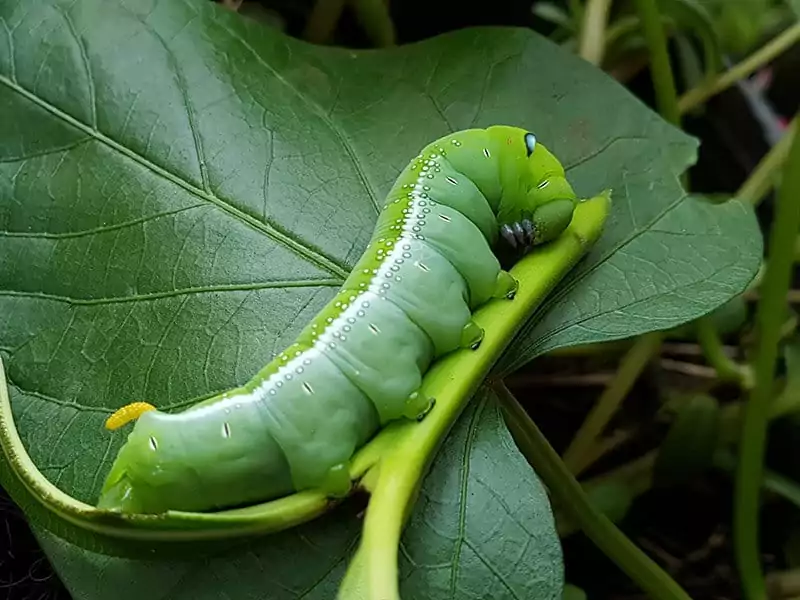
#1 Winter Moth Caterpillar
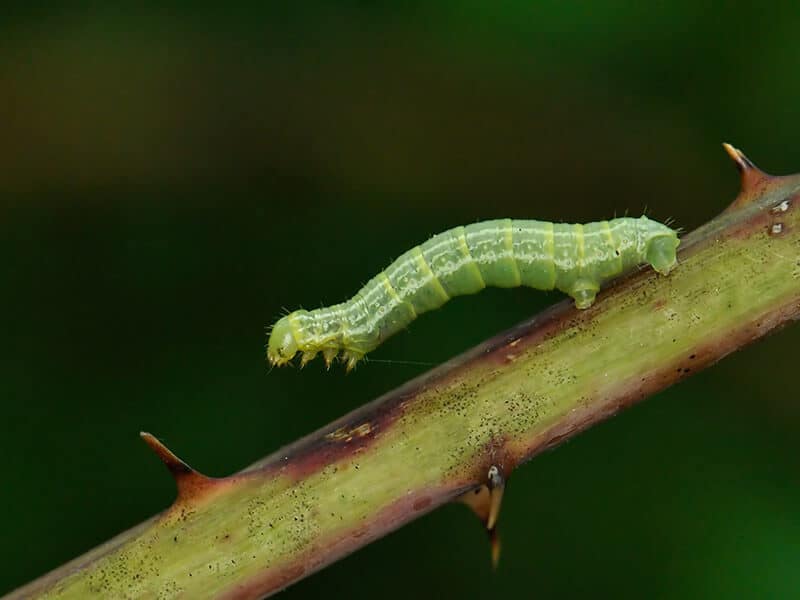
Operophtera brumata or Winter Moth Caterpillar is a rare type of caterpillar that is active in winter, hence the name. These caterpillars eat the leaves of woody plants. Maple, ash, fruit trees and cherries are most prone to the Winter Moth Caterpillars. Sometimes, they eat buds, which makes them very harmful.
#2 Io Moth Caterpillar
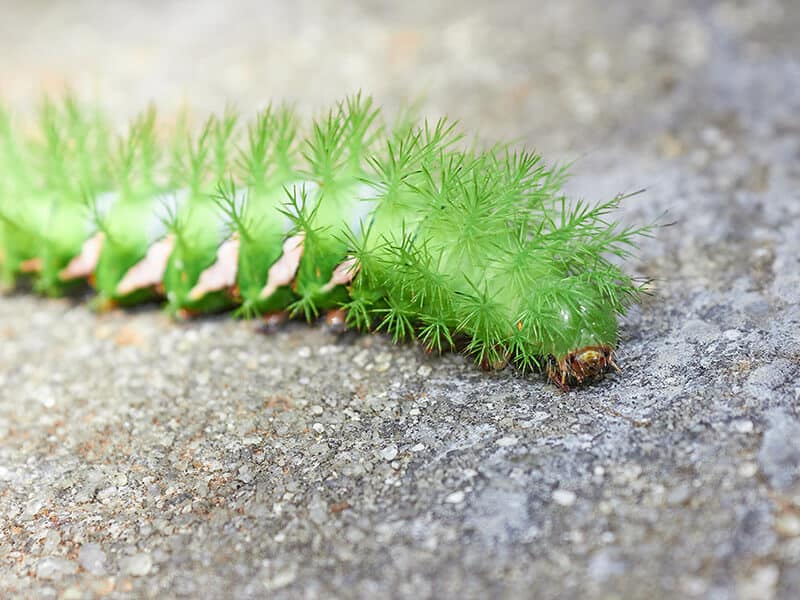
Automeris io or Io Moth Caterpillar develops into a beautiful butterfly with easily recognizable wing eyespots.
Adult caterpillar larvae are about 2 3/3 inches. They feature white and red stripes with black venomous spines.
The caterpillars are known for their painful stings! The caterpillar feeds on trees and shrubs, and willow, aspen, cherry, sassafras and holly are most susceptible to them.
#3 Tomato Hornworm Caterpillar
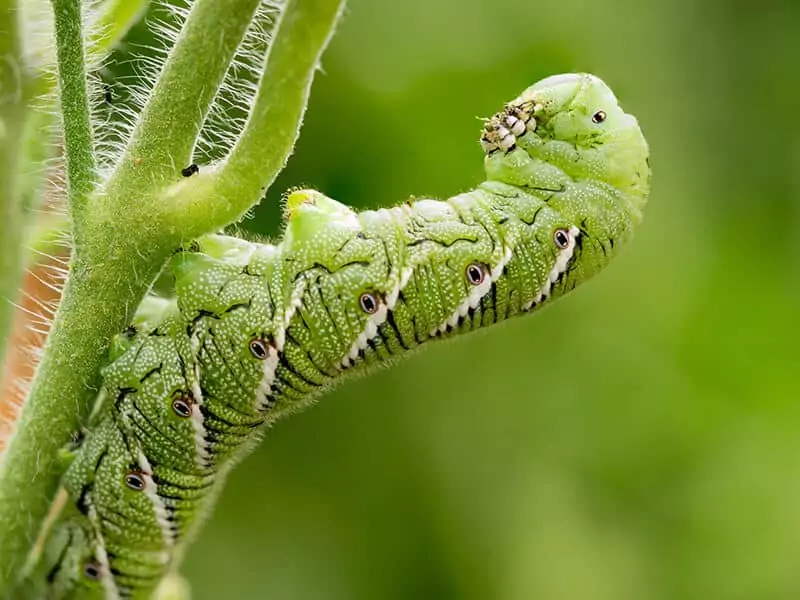
Manduca quinquemaculata is better known under the name Tomato Hornworm. It is one of the largest caterpillars with a horn-like tail. The average length of the caterpillar is around four inches!
The insect got the name because it attacks tomatoes most commonly and can destroy the entire foliage of tomatoes if you don’t react on time.
#4 Genista Broom Moth Caterpillar
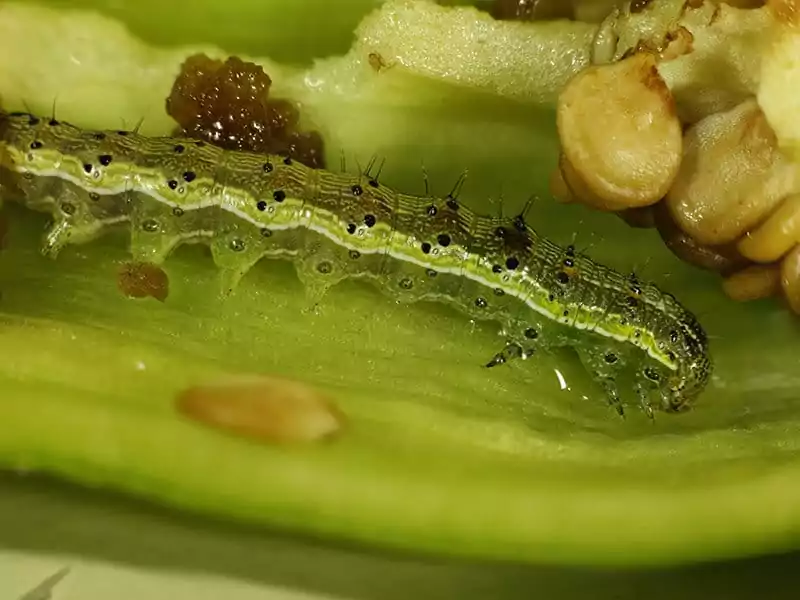
The scientific name of the Genista Broom Moth is Uresiphita reversalis caterpillar. It attacks honeysuckle and crapemyrtle as well as other shrubs from the pea family.
You can get rid of the Genista caterpillars with a water spray and broad-spectrum insecticide. Don’t forget to regularly prune the plants to prevent the caterpillars from invading your shrubs again!
#5 Black Swallowtail Butterfly Caterpillar
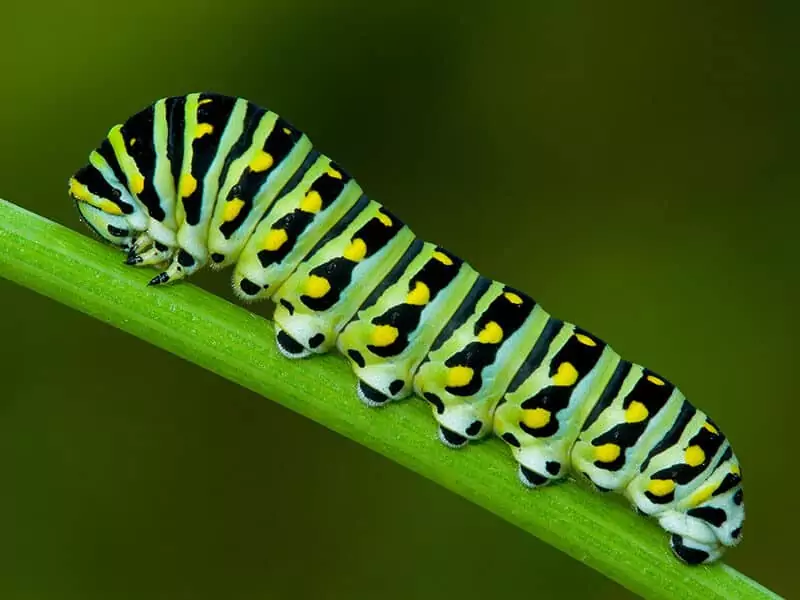
Papilio polyxenes or Black Swallowtail can feed on plenty of plants. But, luckily these caterpillars rarely develop in significant numbers so they cannot cause any substantial harm. They have a unique and easily recognizable appearance with black stripes and yellow dots.
The Black Swallowtail butterfly is praised for its beauty, but can also be considered a pest.
#6 Tiger Swallowtail Butterfly Caterpillar
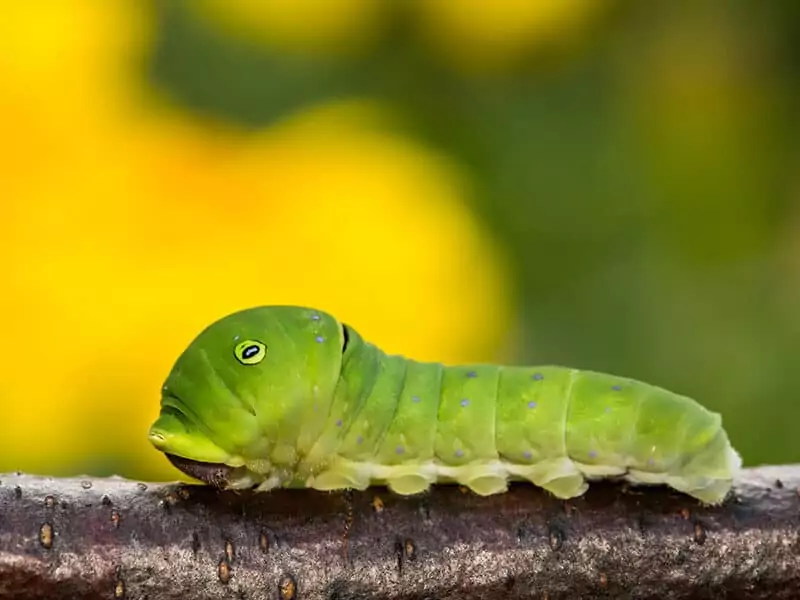
Pterourus glaucus eats the foliage of woody plants. Wild cherry, ash, willow, tulip and birch are the most common host plants for this caterpillar. People also call it the Tiger Swallowtail Butterfly Caterpillar. Adults also feed on butterfly bush, honeysuckle and feed on flower nectars.
The caterpillar can be found in almost all US parts.
#7 White-Lined Sphinx Moth Caterpillar
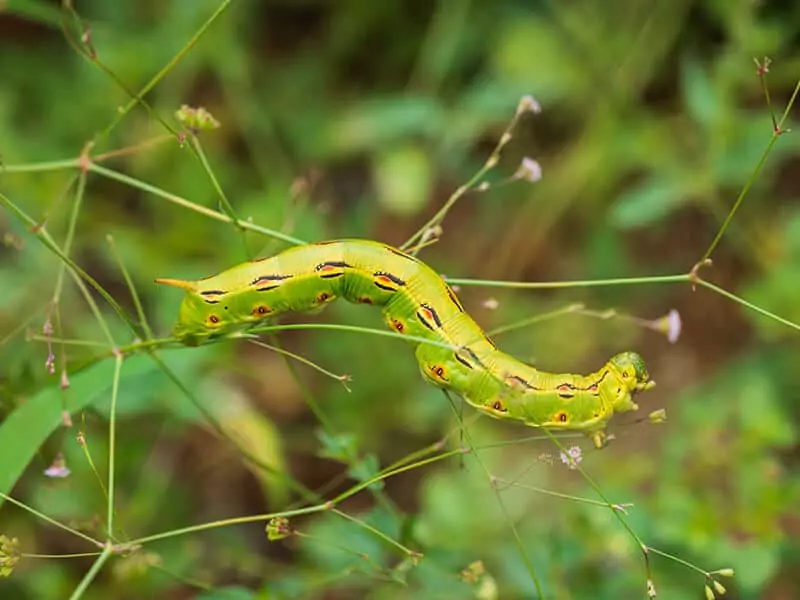
Hyles lineata is one of the most common pollinators. Caterpillar is also called White-lined sphinx and it can use a lot of garden plants for food.
Virginia creeper is one of the plants that can suffer the most from the White-lined sphinx caterpillar. Other plants from the grape family are attractive to caterpillars as well.
#8 Emperor Moth Caterpillar
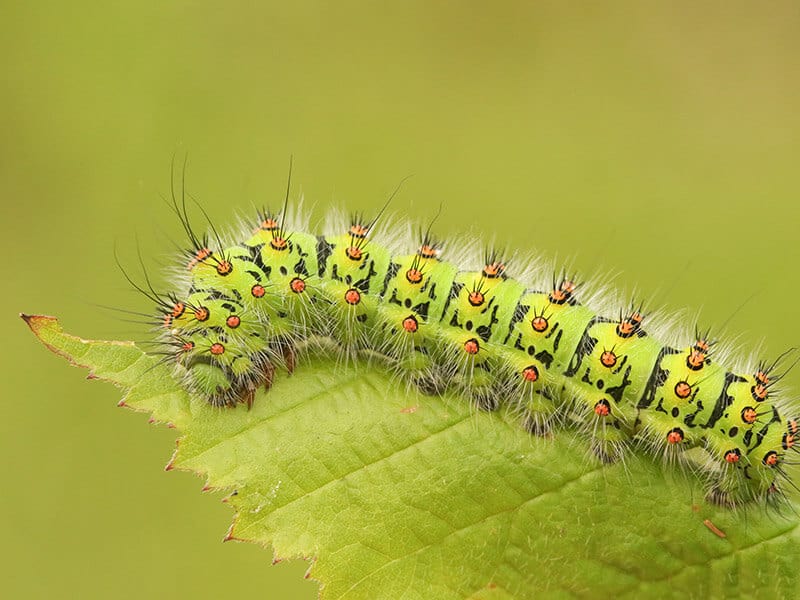
Saturnia pavonia can be found on hedges, bogs and fens. It prefers nutrient-poor grasslands and large woodlands. It is common in the UK, and northern parts of Europe and Asia.
People also call it Emperor Moth because of the heavily scaled wings.
#9 Luna Moth Caterpillar
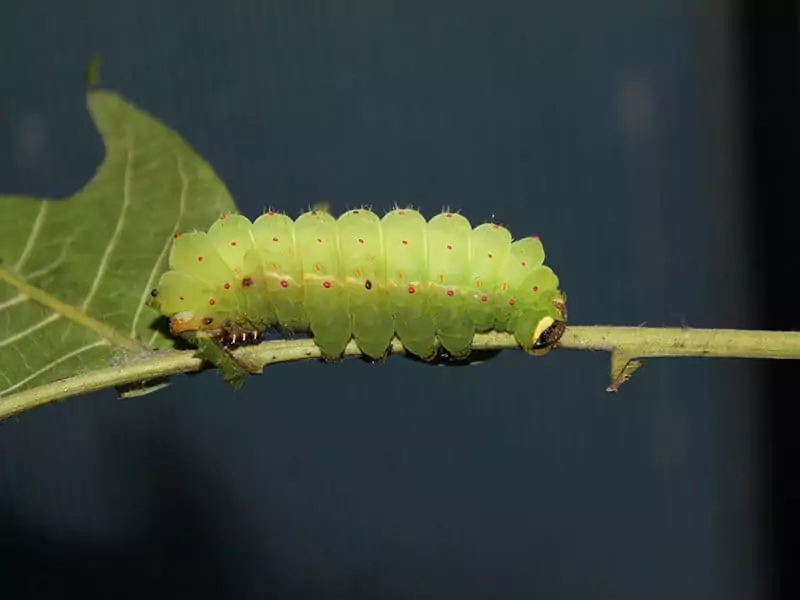
Actias luna is a bright green caterpillar. The insect is also known as the American moon moth or Luna Moth. It belongs to the family of giant silk moths. The caterpillar eats the walnut, sweetgum, paper birch and walnut foliage. After three weeks, it turns into a beautiful moth.
Interestingly, Luna moth was featured on the US Post Office first class stamp decades ago!
#10 European Puss Moth Caterpillar
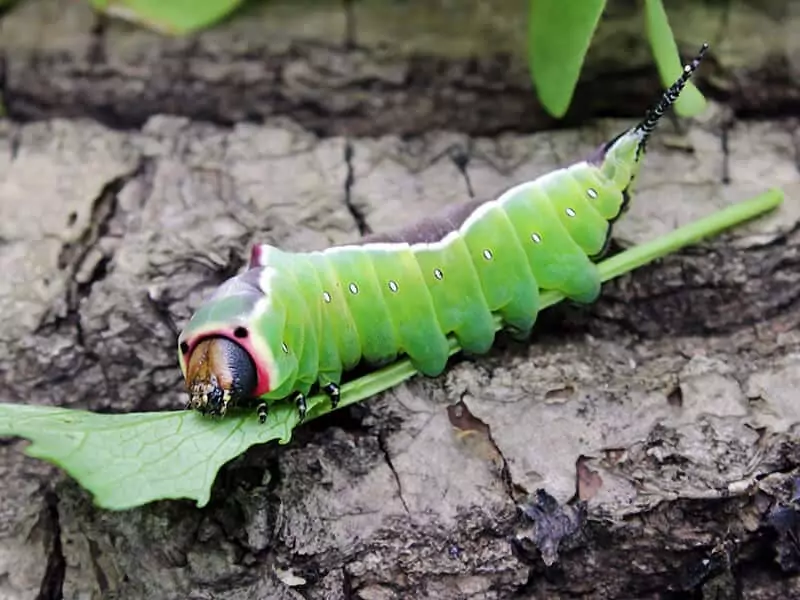
Cerura vinula is the scentific name of the European Puss moth. The caterpillar is somewhat large and features a fuzzy body when transformed into a moth.
Puss moth caterpillar is great at defending itself against threats. It can squirt acid at the threat protect itself!
Caterpillars eat poplars and willow. Those attract new suckers and prevent the plants from developing a bushier appearance.
#11 Cabbage White Butterfly Caterpillar
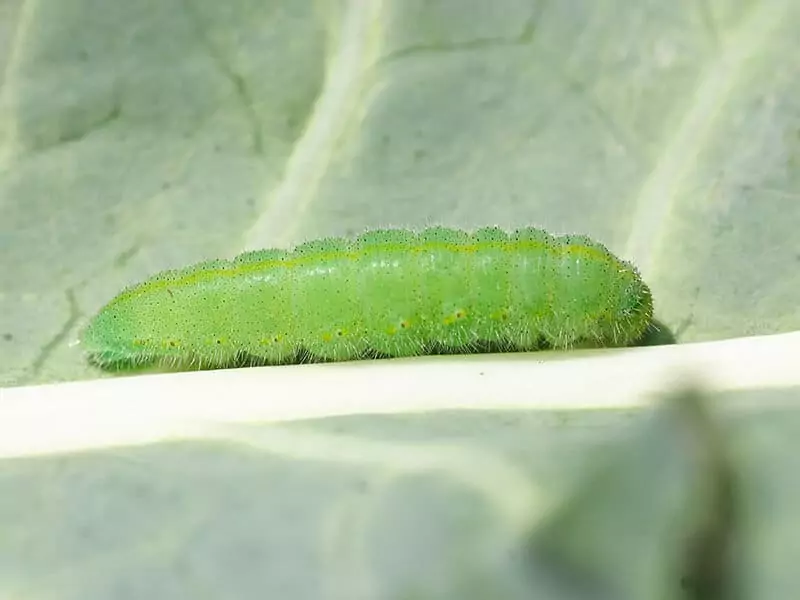
Pieris rapae or Cabbage White Butterfly Caterpillar eats cabbage! The adult lays eggs on the leaf’s undersides. After two weeks, small and hungry caterpillars emerge and start eating your cabbage.
Sometimes, these caterpillars can cause severe damage to your crops and dig a tunnel deep into the centers of the cabbage. Butterfly netting might be a way to prevent these insects from damaging your veggies.
#12 Rustic Sphinx Moth Caterpillar
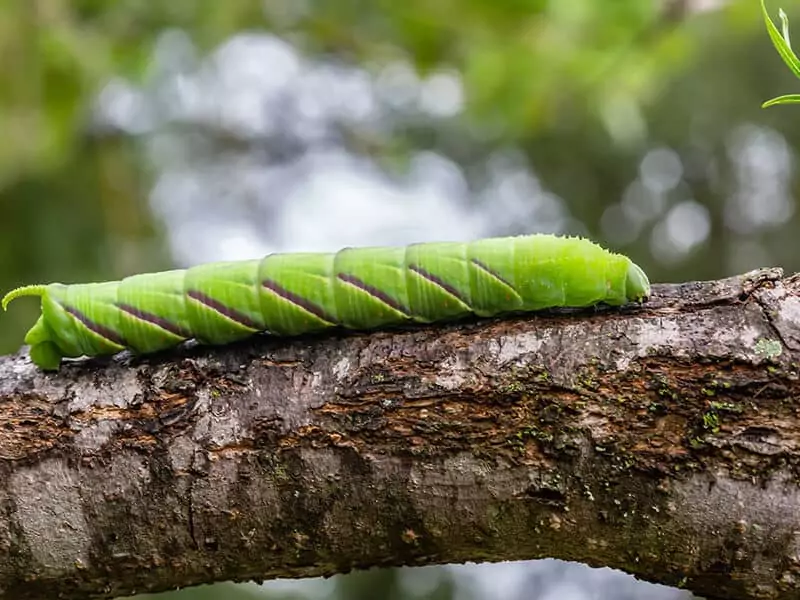
Manduca Rustica’s common name is Rustic Sphinx Moth and it is related to a tomato hornworm. These caterpillars eat fringe trees and jasmine, bushy math grass. Bignonia species are also on the menu of these caterpillars.
These moths lay their eggs in warm environments, most likely subtropical and tropical forests.
#13 Hickory Horned Devil Moth Caterpillar
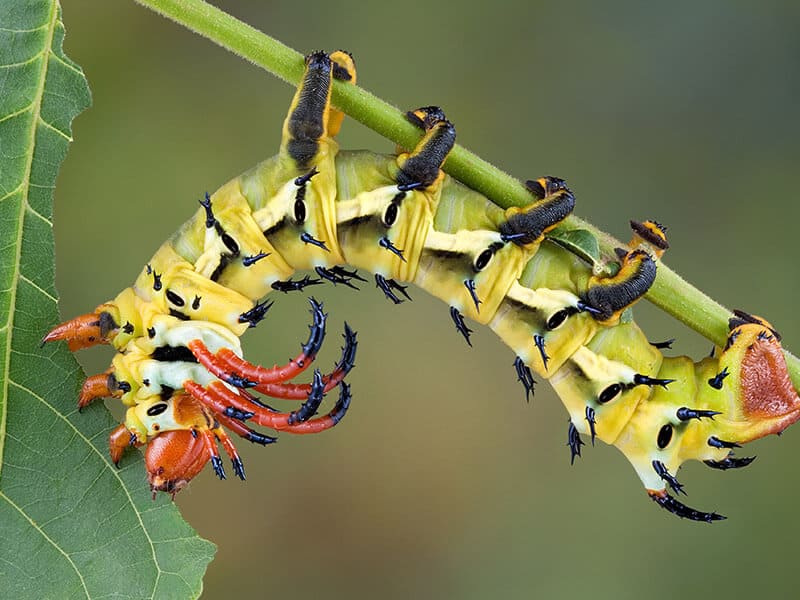
Citheronia regalis insects are unique and easily recognizable caterpillars because of their bright-colored appearance and horns. The insect is sometimes called Regal or Royal moth or Hickory Horned Devil caterpillar.
It is larger than most caterpillars and feeds on the hickory tree, pecan, black walnut, cotton trees and similar woody plants.
#14 Cecropia Moth Caterpillar
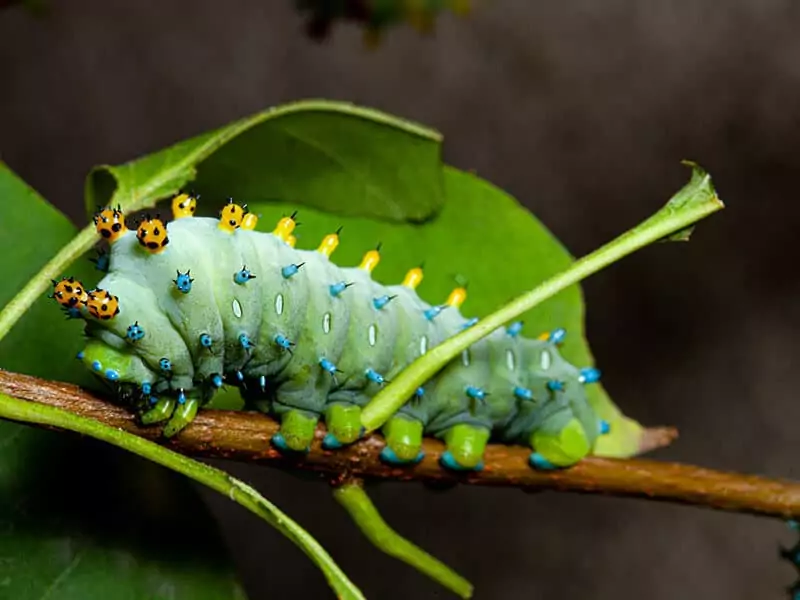
Cecropia Moth Caterpillars chew foliage on shrubs and trees. It can destroy leaves on birch, elm, maple, plum, lilac, apple and similar trees. The adult doesn’t feed, and only lives for several weeks.
The scientific name of the caterpillar is Hyalophora cecropia. You can Cecropia caterpillar across the United States and Canada.
#15 Angle Shades Moth Caterpillar
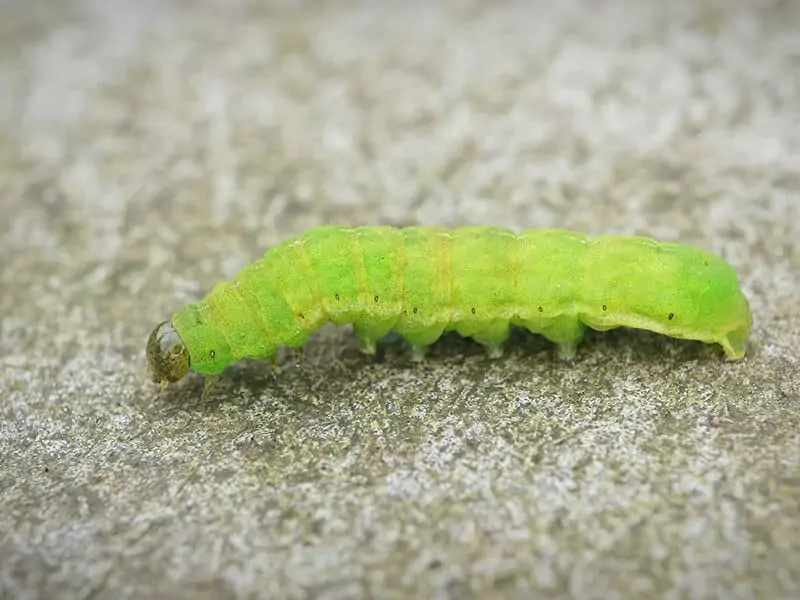
Phlogophora meticulosa caterpillar isn’t picky when it comes to food. The caterpillar can feed on plenty of herbaceous plants, shrubs and trees. Some of the most common host plants are bramble, nettle, dock, and sallow.
Adults love light and prefer to feed on flower nectars at night.
Because of the multi-colored appearance, people also call it Angle shades moth.
#16 Hackberry Emperor Caterpillar
Asterocampa celtis or Hackberry Emperor can be found at the bottom of the dead rolled leaves of the hackberry tree. The easiest way to control the population of caterpillars is to clean fallen leaves regularly.
If the caterpillars appear, you can easily remove them by hand or with broad-spectrum pesticides.
#17 Cabbage Looper Caterpillar
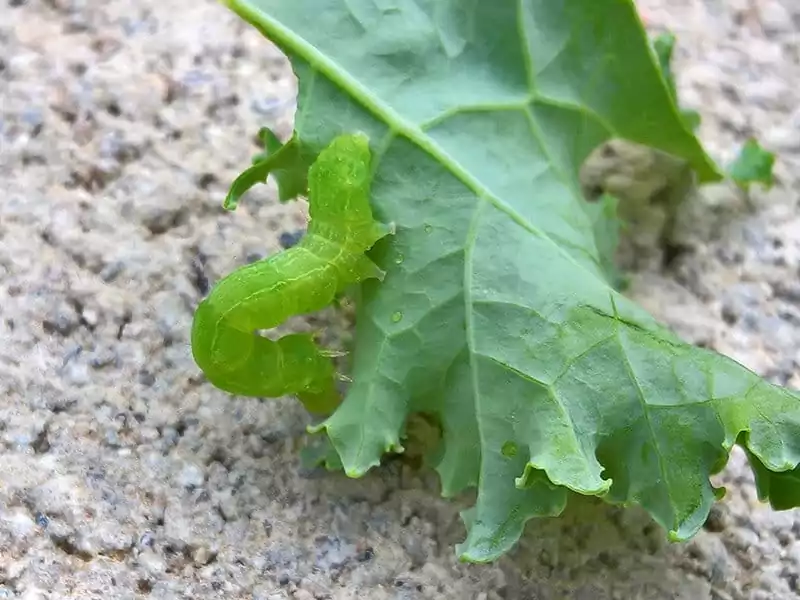
Trichoplusia ni Hübner or Cabbage looper attacks cruciferous plants, including Brussels sprouts, cabbage, cauliflower, broccoli and cabbage. If you don’t treat the infestation, the Cabbage looper can significantly reduce your crops.
They can attack the accompanying veggies in your garden and damage lettuce, spinach, beets, carnations and tomatoes.
The symptoms are riddled leaves with holes. You can remove them by hand or via insecticide soap.
#18 Rough Prominent Moth Caterpillar
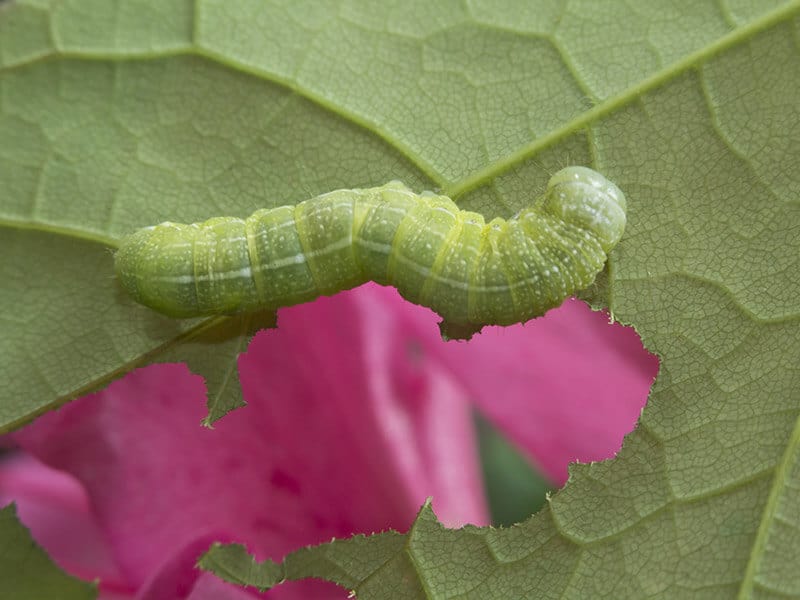
Nadata gibbosa or Rough Prominent Moth Caterpillar or White Dotted prominent lives in deciduous forests. The most common host plants are oak, poplar, rose, maple, alder, birch and chestnut.
Young caterpillars are light green, and the color intensifies as the caterpillar approaches the pupation stage.
#19 Green Cloverworm
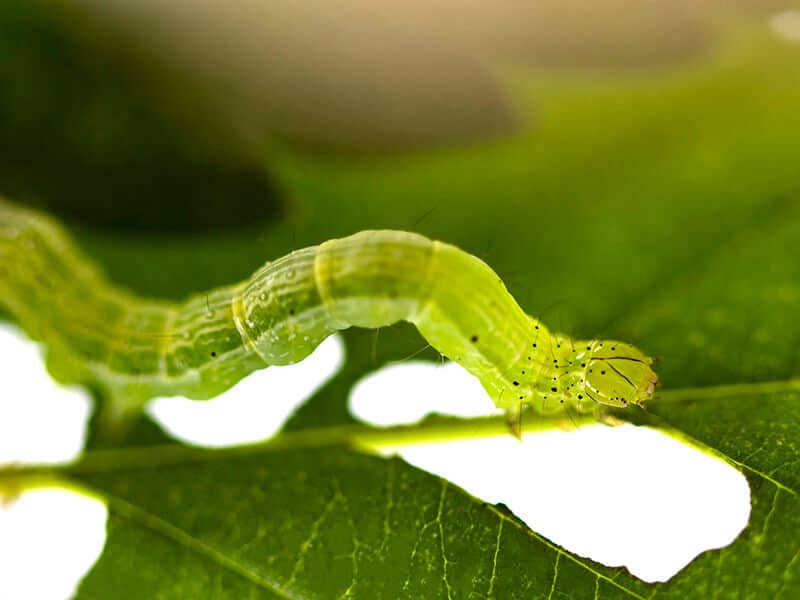
Hypena scabra is the scientific name of Green Cloverworm, a pest known for the defoliation of soybean plants.
Young caterpillars are yellow, and they slowly develop stunning green color as they mature. You can identify the caterpillar by three pairs of legs in the body central part and one or two white stripes on the sides of the body.
#20 Dragon-Headed Caterpillar
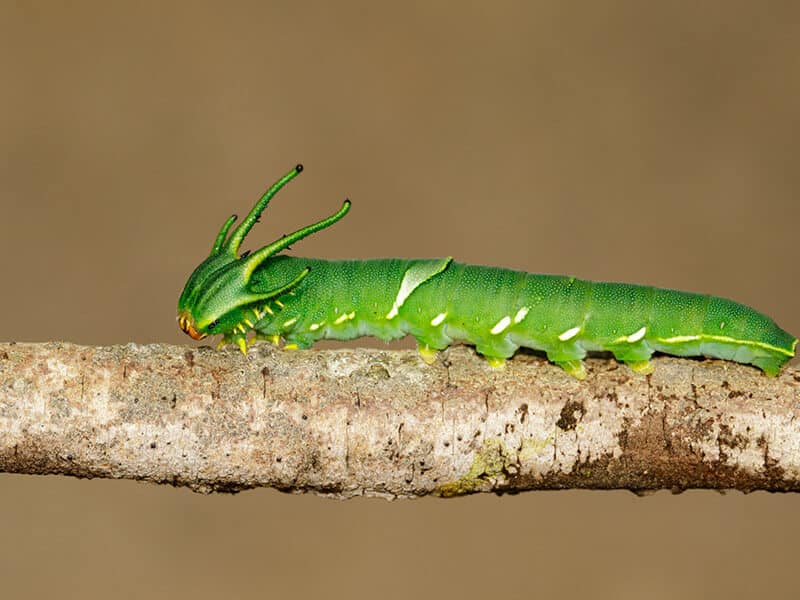
Polyura athamas is possibly the easiest green caterpillar to identify. The caterpillar has a long and green body with four horns. After the metamorphosis is complete, these caterpillars become beautiful Nawab butterflies. Their caterpillars are often called Dragon-headed caterpillars.
You can see this video to know more:
#21 Rosy Maple Caterpillar
Rosy maple caterpillars feature tiny spines with a toxin that can become poisonous in contact with human skin. The caterpillars have green stripes and change color as they become ready to complete metamorphosis.
Red maples, silver and sugar maples, as well as turkey oaks, are the most common host plants for rosy maple caterpillars. The scientific name of these insects is Dryocampa rubicunda.
#22 Cross-Striped Cabbage Worm
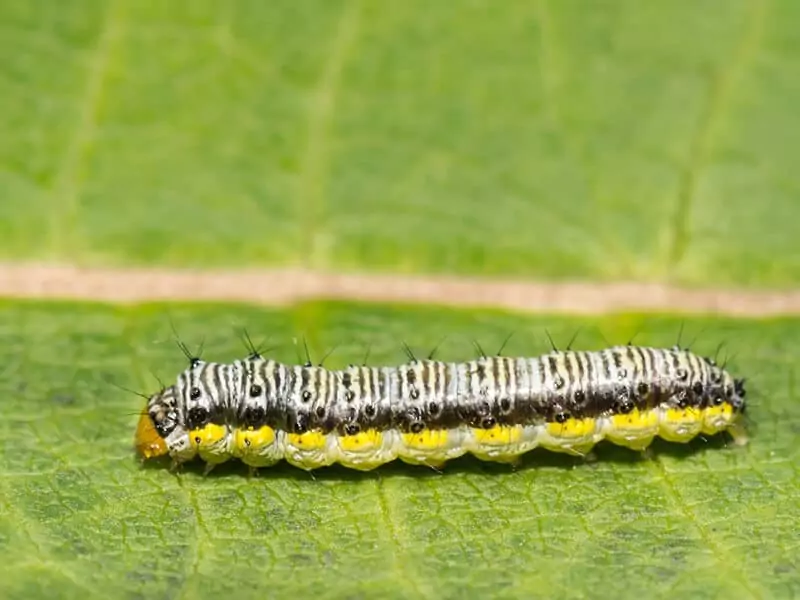
Evergestis rimosalis or Cross-striped cabbageworm is another pest that attacks cruciferous vegetables. They feature black and blue stripes on the back, hence the name.
The treatment of Cross-striped cabbage worms is similar to treatment for cabbage loopers. You can remove them by hand or use insecticide.
#23 Tobacco Hornworm Caterpillar
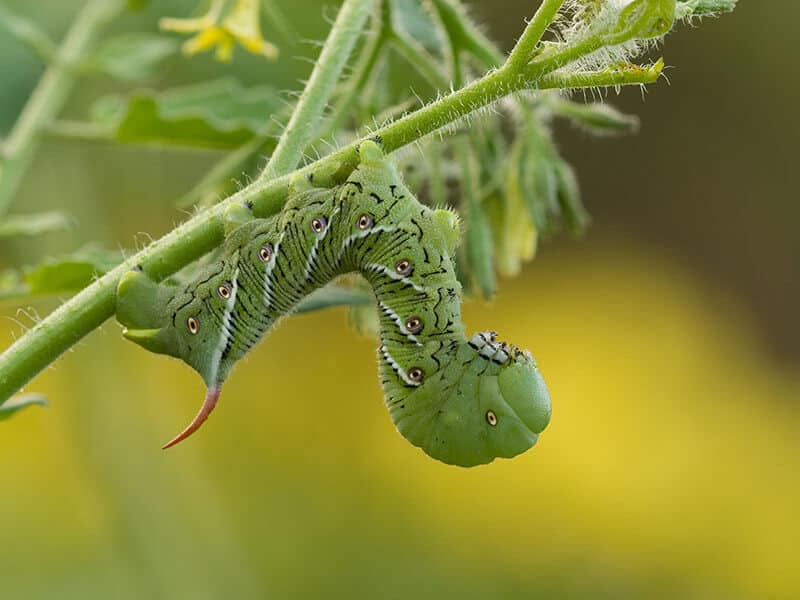
Manduca sexta caterpillars feed on multiple plants, including tobacco, eggplant, pepper, weeds and ornamental plants. It is sometimes called a Tobacco hornworm caterpillar.
You can identify the plant by the white diagonal stripes on the sides of the green caterpillar body and reddish horns. If you notice them, react immediately to prevent significant damage to your crops. You can use insecticides that are safe for pollinators.
#24 Spicebush Swallowtail Caterpillar
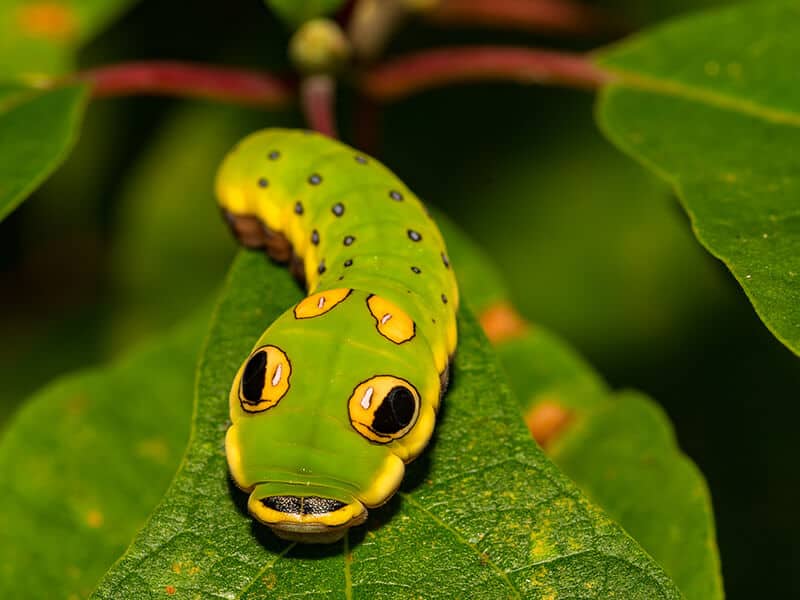
Papilio Troilus or Spicebush Swallowtail Caterpillar is easy to identify once it reaches the fifth instar stage. The down part of the larva is brown, and the upper part is green with bright blue dots.
The head is somewhat thicker than the rest of the body with easily recognizable eyespots. Host plants are spicebush, red and sweet bay, camphor tree and sassafras.
You can see this video to know more:
#25 Cloudless Sulfur Butterfly
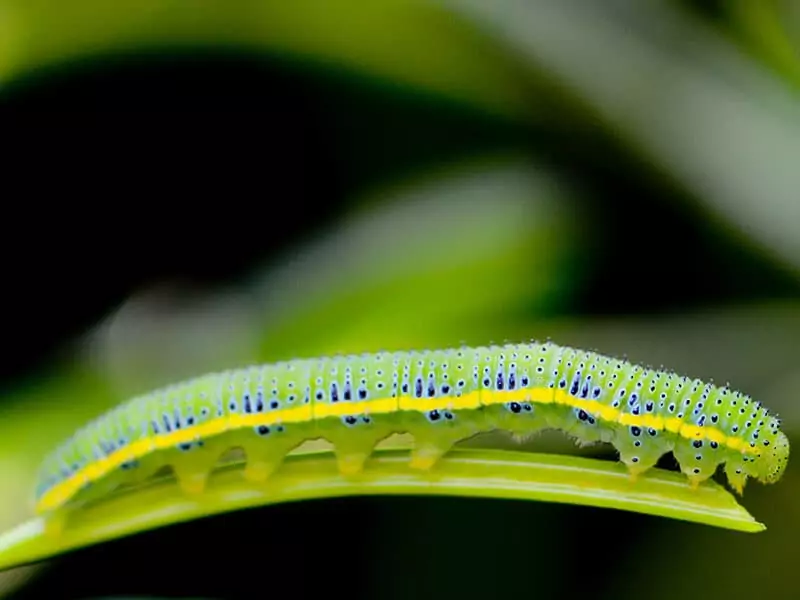
Phoebis sennae is one of the most common insects in Florida. You probably know it under the name Cloudless Sulfur Butterfly. It features a yellow-green underside with side strips and back dots. The average length is between 1.6 and 1.8 inches.
The caterpillar feeds on legumes. But, adult plants love Mexican sage, hibiscus, morning glory and milkweeds.
#26 Crowned Slug Caterpillar
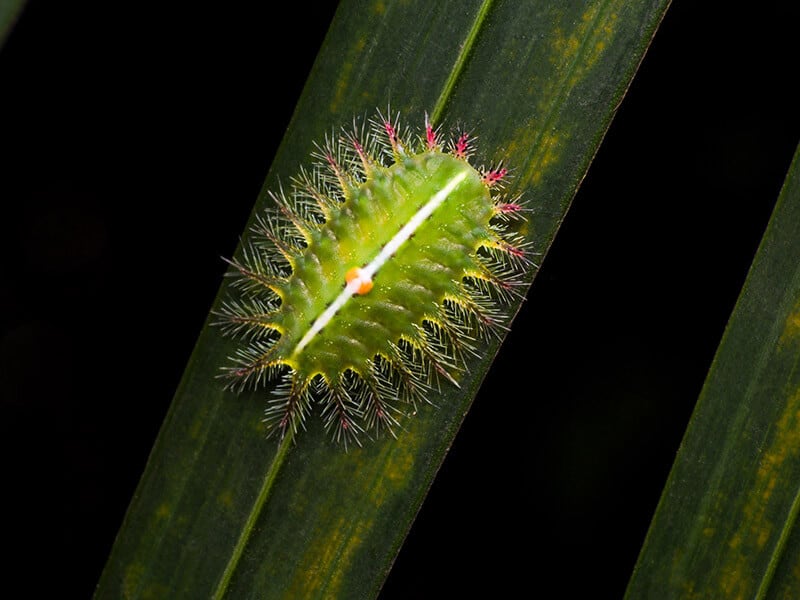
Isa textula or Crowned slug caterpillar is oval and pastel green. The body is covered with stinging hairs and two pale lines on the back. The caterpillar feeds during summer and sometimes, it can destroy the yellow foliage in the fall.
You can find them on various trees and shrubs, including elms, maple, hickories, oaks, etc.
#27 Fall Webworm
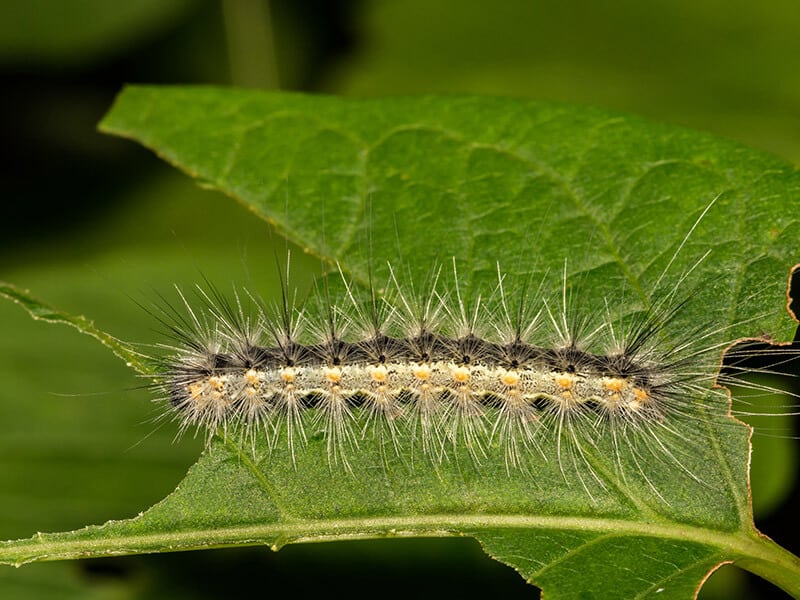
Hyphantria cunea caterpillars are small, around 1 inch long. Their body is covered with soft hair and shouldn’t sting.
Fall webworms don’t attack fruits. But, these caterpillars can stress the plant out and cause the plant to drop the leaves entirely. To prevent it, you need to react in time! The most effective treatment against Fall webworms is dormant oil.
#28 Oak Slug Caterpillar
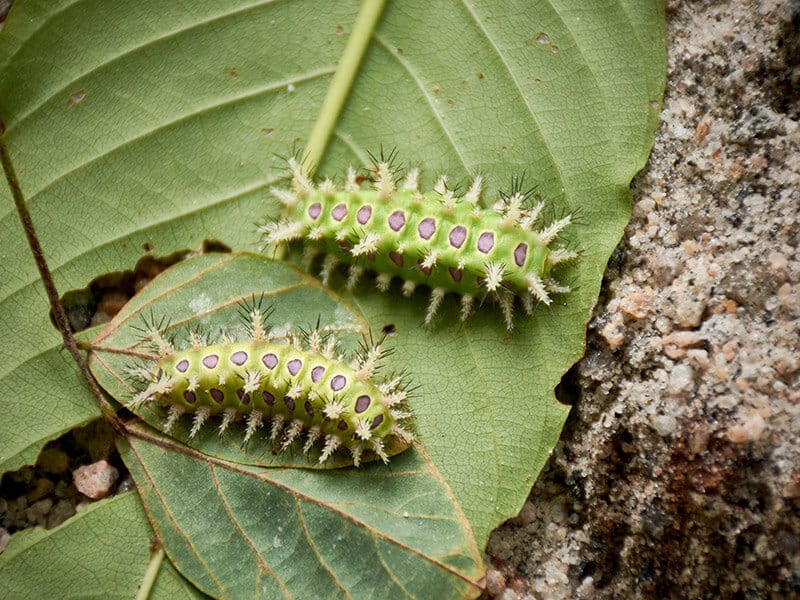
Euclea delphinii lives mostly in deciduous forests and is active from July to October. The caterpillar is flat and oval, with tiny tubercles spread across the body. They can sting humans and cause itching and burning sensations.
You can find them on the apple, ash, birch, maple, oak, hickory, and other similar trees. The common name is Oak slug caterpillar.
You can see this video to know more:
#29 Diamondback Moth Caterpillar
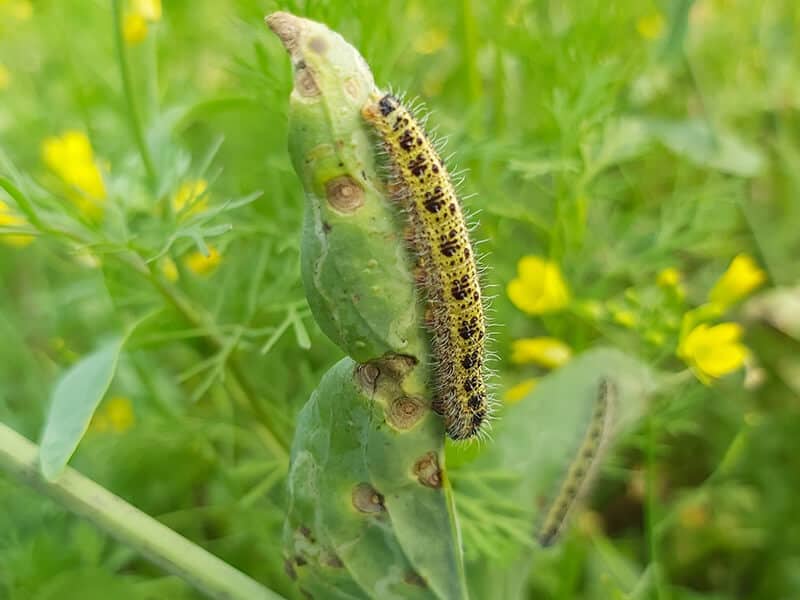
Plutella xylostella can cause significant damage to your crops. Therefore, treatment with synthetic pyrethroid is recommended, especially if the infestation happens in a growth stage.
These caterpillars are also called Diamondback, and they chew cruciferous plants’ foliage. Young larvae don’t have any specific color. But as they mature, the color transforms to green. The caterpillar’s body is covered with a few hairs and small white patches.
#30 Copper Underwing Moth Caterpillar
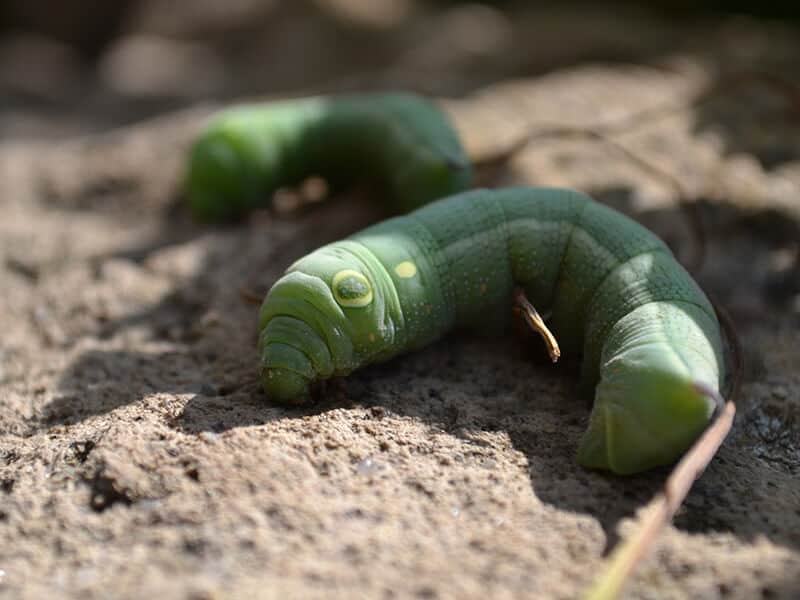
Amphipyra pyramidea or Copper Underwing Moth caterpillar feeds on many trees and shrubs. But, the most common host plant is an oak tree. You can recognize the larvae by the bright green body, distinctive white stripe surrounded by tiny black spots.
#31 Svensson’s Copper Underwing
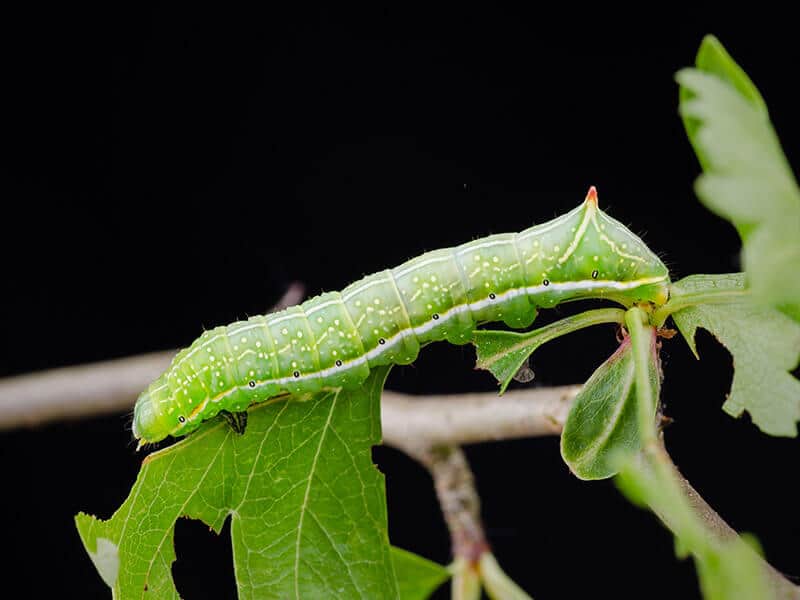
Amphipyra berbera is similar to the previous caterpillar. But, the adults have different patterns on the wings. Additionally, Svensson’s Copper Underwing caterpillar has a more uniformly colored body.
You can find it on a willow tree, oak, aspen, maple, lilac and rowan. Wisteria can also be susceptible to Swensson’s copper underwing.
#32 Polyphemus Moth
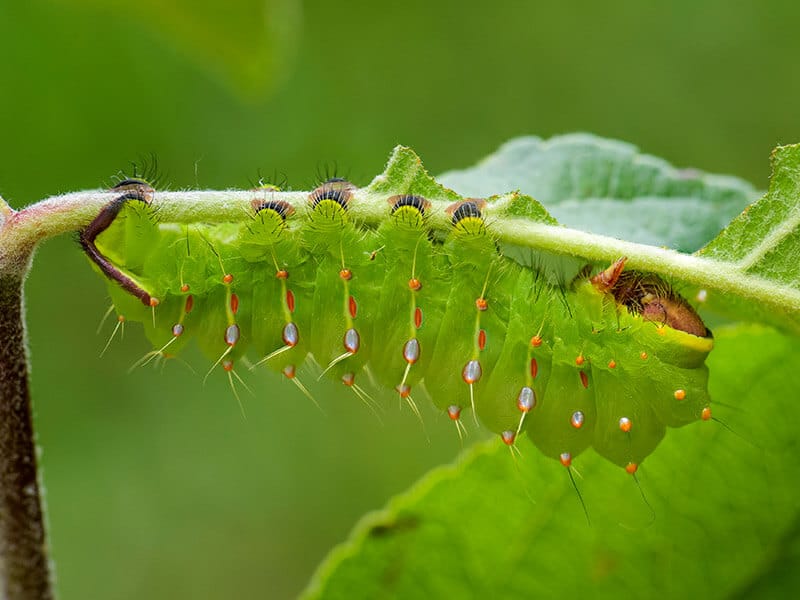
Antheraea polyphemus caterpillar has a bright green body and a reddish head. You can identify them by their six orange tubercles on the body.
The average length of the caterpillar is under three inches. As an adult, the Polyphemus moth is one of the largest insects on the list.
You can find caterpillars on grapes, willow, rose, maple, and birch.
Fascinating Green Caterpillar Can Sting And Harm You Crops
There are so many types of green caterpillars that grow into unique moths. Some of them have hairs that can break the skin and cause skin reactions, such as redness, rash and itching. Others are completely harmless to humans, and only destroy crops.
Have you identified any of the caterpillars from my list in your garden? Have you removed them?
I hope you found the article useful!
